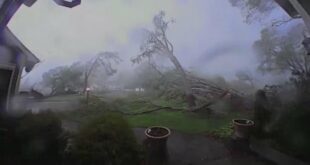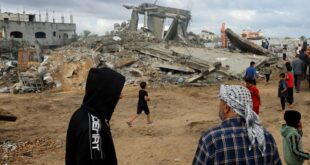Experts say situation offers insight into effects of climate change on mosquito-borne illnesses

Peru is battling the worst dengue outbreak in its recorded history, with more than 140,000 registered cases so far this year, and more than 200 people believed to have died from complications related to infections.
Dengue is prevalent throughout Peru, particularly in lower altitudes, though cases typically drop off as the weather becomes drier.
But not this year.
The rainy weather that allows mosquito populations to breed — in pools, puddles and any standing water — hasn't let up thanks, in part, to El Niño — the natural, recurring phenomenon that brings warm conditions to the eastern Pacific Ocean and disrupts weather patterns around the world.
Here is what you need to know about dengue and why weather conditions exacerbated by El Niño, and other factors, may lead to even more infections in Peru and elsewhere.
What is dengue?
Dengue is a virus carried by Aedes mosquitoes, the same species responsible for the transmission of other diseases including yellow fever, Zika and chikungunya.
While those mosquitos are present on every continent, except Antarctica, they are most prevalent in tropical and subtropical climates.

People who contract the virus might not always exhibit symptoms but those who do can experience high fever, headache, body aches, nausea and/or rash.
There's no medical treatment, but most people "get over it with a little misery," said infectious diseases specialist and microbiologist Dr. Michael Libman, the director of the Centre for Tropical Medicine at McGill University in Montreal.
However some infections can become severe resulting in shock, shortness of breath, severe bleeding, organ damage and death.
Children are particularly at risk from severe cases, when dengue can cause a hemorrhagic fever that can be "quite deadly," said Dr. David Fisman, a professor of epidemiology at the University of Toronto's Dalla Lana School of Public Health.

How does El Niño make it worse?
Peru's confirmed case numbers this year are already double those of 2017, when the World Health Organization declared a dengue epidemic in the country as a smaller El Niño effect caused intense rain and flooding.
Fisman says El Niño can easily exacerbate an outbreak.
"More mosquitoes, more bites," he said, explaining how an explosion in mosquito populations, due to optimal breeding conditions, also increases the virus "reservoir." As dengue-carrying mosquitoes infect more people, he said, uninfected mosquitoes then pick up the virus from those humans and subsequently spread it further among the human population.
Further, the effects of El Niño are different around the world and the increased temperatures it fuels can create drought conditions that also boost mosquito populations — by turning flowing water into standing pools where they can breed.

A Brazilian mosquito factory is planning to release 5 billion modified mosquitos a year to help combat dengue fever. We hear more from Scott O’Neill, a microbiologist at Monash University in Melbourne, Australia, and CEO of the World Mosquito Program.
What can we learn from Peru?
There is, of couse, no Earth-like "control planet" free of climate change to compare the changes happening on Earth. But with El Niño — and its opposite, ocean-cooling pattern La Niña — occurring every two to seven years, it can offer some insight into how extreme weather can affect the spread of viruses like dengue, said Fisman.
"It's sort of like an experimental system that simulates what we anticipate we'll be seeing more and more under climate change scenarios," he said. Climate change is also expected to affect the intensity of El Niño cycles.
But warming planet temperatures, caused by El Niño or climate change — or both — won't just fuel mosquito breeding cycles, they may also expand the range of those mosquitoes, said McGill's Libman.
That range is expanding northward, which he says is concerning.

The Aedes mosquitoes are found in southern pockets of the contiguous U.S., including Texas and Florida, though the number of locally transmitted cases are quite low.
Dengue-carrying mosquitoes are "not in Canada yet, but they're not that far either," Libman said.
Aedes aegypti mosquitoes, which are more likely to spread diseases like dengue to people, are not present in Canada. Aedes albopictus mosquitoes, which can transmit dengue and other arboviruses to a lesser extent, have appeared in a small corner of southwestern Ontario, though there are no indications they carry exotic illnesses.
Libman says if warming conditions allow either type to thrive in traditionally temperate regions, there is the possibility arboviruses like dengue could adapt, and perhaps be spread more freely by Aedes albopictus mosquitoes.
He cited the example of the chikungunya virus, which wasn't present in the Western hemisphere until 2013. Fisman says chikungunya was typically carried by the Aedes aegypti mosquito but adapted to the Aedes albopictus species and "spread like crazy in the Americas where there was no immunity."
"It's not out of the question that the [dengue] virus, at some point or another, there will be changes that allow it to be transmitted even in a place like ours," he said.

Larviciding for mosquitoes
City workers are hitting the ditches, spraying biological larvicide to prevent swarms of mosquitoes from growing up this spring.
ABOUT THE AUTHOR

Senior Writer
Nick Logan is a senior writer with CBCNews.ca based in Vancouver. He has worked as a multi-platform reporter and producer for more than a decade, with a particular focus on international news. You can reach out to him at nick.logan@cbc.ca.
With files from Reuters
*****
Credit belongs to : www.cbc.ca
 MaharlikaNews | Canada Leading Online Filipino Newspaper Portal The No. 1 most engaged information website for Filipino – Canadian in Canada. MaharlikaNews.com received almost a quarter a million visitors in 2020.
MaharlikaNews | Canada Leading Online Filipino Newspaper Portal The No. 1 most engaged information website for Filipino – Canadian in Canada. MaharlikaNews.com received almost a quarter a million visitors in 2020.







